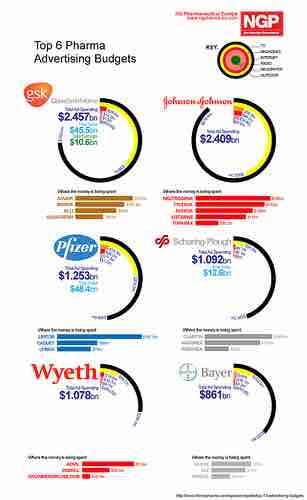Introduction
How do marketers decide on their advertising budget?

Top 6 Pharma Advertising Budgets
A company's advertising budget depends on various factors such as profit objectives, target market, business age, and industry.
- Set a preliminary budget based on chosen tasks.
- Estimate the budget of competitors and adjust accordingly.
- Prepare a budget document with the rationale of expenses.
- Use a percentage of sales.
The most common method is using a percentage of sales. However, what happens if sales go down? The problem you are trying to correct already has less money to begin with. However, it is used time and time again.
Instead of making such a cut-and-dry calculation, marketers should ask themselves a series of questions that will help them create an effective and realistic advertising budget that is in line with their sales and marketing goals.
What to Consider
Who are you targeting?
The best way to determine the answer to this question is to create a profile of your customers. How are old are they? Where do they work? Are they male, female, or both? What are their beliefs and attitudes? Be specific. Everyone can't be your audience, so knowing who is can help you choose the best message and media to reach your goals.
What type of media does your target audience pay attention to?
These days marketers have a myriad of media choices to choose from. But it is very unlikely that you are going to reach a senior citizen using the same media you need to reach a teenager. See why it's important to know who your real target audience is?
What type of appeal is needed to persuade your target audience to buy?
Emotional or rational? Using the wrong one will not give you the sales you want no matter how much you spend on producing and airing it.
How much profit is likely to be generated for each dollar spent on advertising?
This will keep you from advertising just for the sake of advertising.
How old is your business or product ?
An unknown business is going to have to spend much more on advertising than one that is already established in the mind of its customers.
What is your product or service?
Sometimes word of mouth works better than a full page spread in the Financial Times.
What are your profit margin expectations?
Even once your business is established, you may continue to want to spend a lot on advertising to keep your product in the mind of your target market.
Creating the Budget
After analyzing the market situation and identifying corporate goals, marketers can proceed to determine how much to spend on advertising. Marketers tend to use several techniques to determine an advertising budget. Here's a list of the most common ones.
Arbitrary allocation - Management bases the budget on personal experience, business philosophy, and marketing intuition.
Affordability - Anticipated promotion costs are the basis for this method with the upper limit of the budget based on the availability of company resources.
Ratio-to-sales - The amount budgeted is based on some portion of past or forecasted sales.
Competitive comparisons - The budget is based on the amount spent by major competitors.
Experimental approach - The budget is based on test market results.
Objective-task method - The budget is determined by calculating the costs of reaching specific promotional objectives and sum amounts.